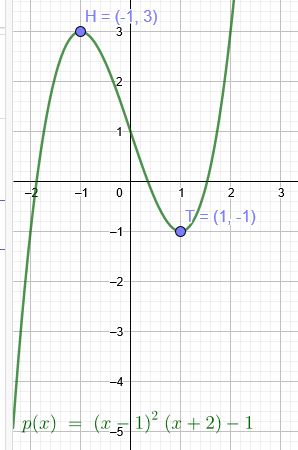T \(( 1 | -1 )\) und H \(( -1 | 3 )\)
T \(( 1 | -1 )\) → T´ \(( \red{1} | 0 )\) doppelte Nullstelle und H \(( -1 | 3 )\)→ H´ \(( -1 | 4 )\)
\(f(x)=a(x-\red{1})^2(x-N)\)
H´ \(( -1 | 4 )\):
\(f(-1)=a(-1-1)^2(-1-N)=4a(-1-N)=4\)
\(a(-1-N)=1\)
\(a=\frac{1}{-1-N}\):
\(f(x)=\frac{1}{-1-N}[(x-1)^2(x-N)]\)
\(f'(x)=\frac{1}{-1-N}[(2x-2)(x-N)+(x-1)^2\cdot 1]\)
In jedem Hochpunkt ist eine waagerechte Tangente:
H´ \(( -1 | ... )\):
\(f'(-1)=\frac{1}{-1-N}[(-2-2)(-1-N)+(-1-1)^2]=0\)
\((-1-N)=1\)
\(N=-2\):
\(f(x)=(x-1)^2(x+2)\)↓
\(p(x)=(x-1)^2(x+2)-1\)
